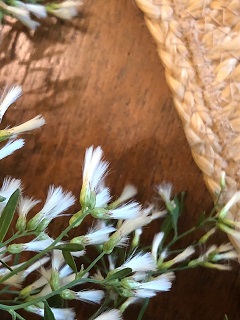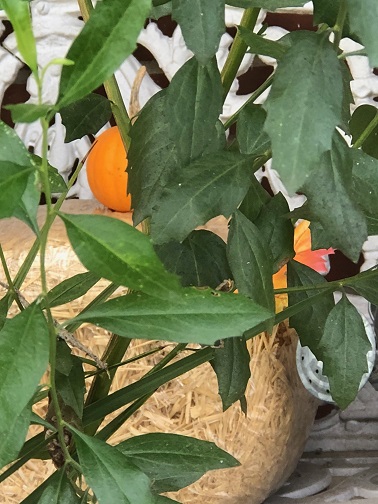Groundsel Bush
December 1, 2018
![]()
This tree/bush every fall has these copious white flowers if they can be called that. I can’t find it in my Carl Hunter books. Any ideas?

![]() The plant in question is groundsel bush, Baccharis halimifolia. The plant is in the
daisy family and native to the coastal areas of the southeastern US but it is spreading.
We see it getting thicker and thicker every season on roadsides. It is showy in the
late fall and early winter, but it freely reseeds itself and can become quite invasive.
There are separate male and separate female flowers, with the females more showy.
In the saltwater heavy native areas, it is commonly called Salt bush because it is
tolerant of salt sprays.
The plant in question is groundsel bush, Baccharis halimifolia. The plant is in the
daisy family and native to the coastal areas of the southeastern US but it is spreading.
We see it getting thicker and thicker every season on roadsides. It is showy in the
late fall and early winter, but it freely reseeds itself and can become quite invasive.
There are separate male and separate female flowers, with the females more showy.
In the saltwater heavy native areas, it is commonly called Salt bush because it is
tolerant of salt sprays.
November 24, 2018
![]()
She has a plant that grew up in another plant she purchased that she is unsure of. I have attached photos of the plant. Could you help us identify the type of plant? Thanks in advance for your help!

![]()
I believe the plant in question is commonly called groundsel bush – Baccharis halimifolia. It is the plant you see dotting the roadsides this time of year with white flowers. This plant is dioecious which means there are separate male and female plants. The showy one is the female, and the white color is actually silky hairs, much like you see on dandelion flowers. Female flowers will have many of these white bristles or hairs, while the male flowers will have few. They are fairly weedy looking until they begin their fall bloom. It freely reseeds itself, which could be the reason for it appearing in the potted plant.
November 11, 2017
![]()
These beautiful roadside shrubs are in full bloom along highway 65 in SE Arkansas. There seem to be male and female versions as you’ll see blooming next to non blooming trees. What are they?
![]() We get this question almost every fall as the Groundsel bush (Baccharis halimifolia).
There are separate female and separate male plants. The female plants have the showy
flowers which are feathery seed pods similar to what a dandelion produces. They are
a bit too aggressive to be a shrub in the home landscape.
We get this question almost every fall as the Groundsel bush (Baccharis halimifolia).
There are separate female and separate male plants. The female plants have the showy
flowers which are feathery seed pods similar to what a dandelion produces. They are
a bit too aggressive to be a shrub in the home landscape.
December 2005
![]() Would you know what the small bushy trees along many roadsides and ditches are with
narrow willow-type leaves and in November are covered in tiny white blooms? I had
one that came up in my back yard in Maumelle this spring and it grew to 6 feet by
the end of this season! I was wondering if I need to cut it down, thanks!
Would you know what the small bushy trees along many roadsides and ditches are with
narrow willow-type leaves and in November are covered in tiny white blooms? I had
one that came up in my back yard in Maumelle this spring and it grew to 6 feet by
the end of this season! I was wondering if I need to cut it down, thanks!
![]() This is a common question every year. The plant in question is the Groundsel Bush,
or Baccharis halimifolia. This native plant can be found commonly in the southern
half of Arkansas. It is extremely showy this year. It is dioecious which means there
are separate male and female plants. The showy one is the female, and the white color
is actually silky hairs, much like you see on dandelion flowers. Female flowers will
have many of these white bristles or hairs, while the male flowers will have few.
They are fairly weedy looking until they begin their fall bloom. They have not been
known to be that weedy in the U.S., but are considered a noxious weed in Australia.
The jury is still out as to the groundsel's place in the home landscape. Watch it
for a year or two and see if it spreads.
This is a common question every year. The plant in question is the Groundsel Bush,
or Baccharis halimifolia. This native plant can be found commonly in the southern
half of Arkansas. It is extremely showy this year. It is dioecious which means there
are separate male and female plants. The showy one is the female, and the white color
is actually silky hairs, much like you see on dandelion flowers. Female flowers will
have many of these white bristles or hairs, while the male flowers will have few.
They are fairly weedy looking until they begin their fall bloom. They have not been
known to be that weedy in the U.S., but are considered a noxious weed in Australia.
The jury is still out as to the groundsel's place in the home landscape. Watch it
for a year or two and see if it spreads.
All links to external sites open in a new window. You may return to the University of Arkansas System Division of Agriculture web site by closing this window when you are finished. We do not guarantee the accuracy of the information, or the accessibility for people with disabilities listed at any external site.
Links to commercial sites are provided for information and convenience only. Inclusion of sites does not imply University of Arkansas System Division of Agriculture's approval of their product or service to the exclusion of others that may be similar, nor does it guarantee or warrant the standard of the products or service offered.
The mention of any commercial product in this web site does not imply its endorsement by the University of Arkansas System Division of Agriculture over other products not named, nor does the omission imply that they are not satisfactory.